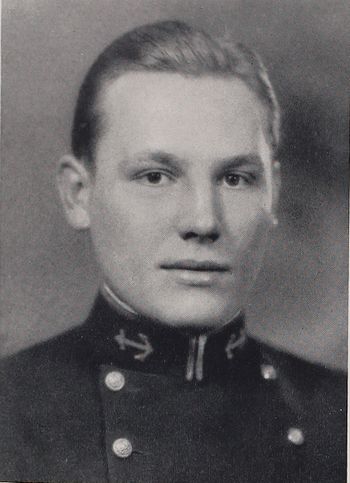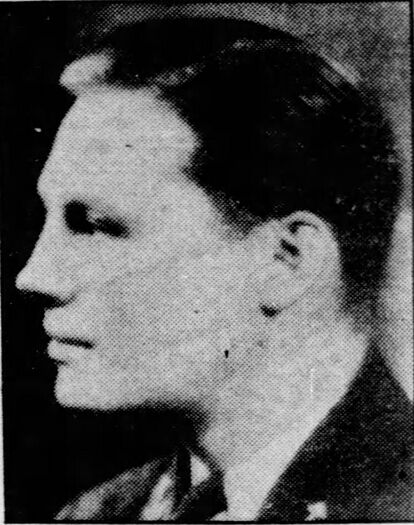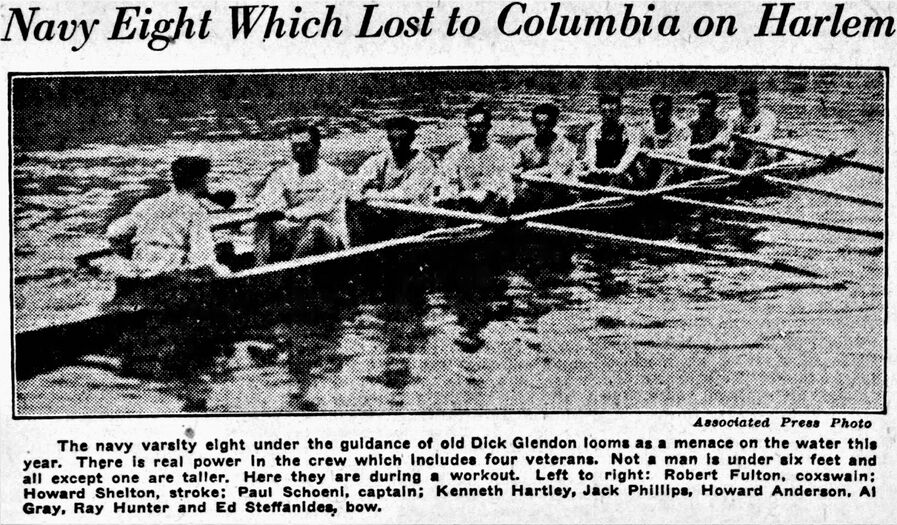HOWARD E. SHELTON, LT, USN
Howard Shelton '32
Lucky Bag
From the 1932 Lucky Bag:
Howard E. Shelton, Jr.
Paducah, Kentucky
“Bobo”, “Peewee”, “Bo”
Straight from Paducah came our Bo on the way paved by Josie Clifton. Early in Plebe year he realized that academics would hardly prove a serious handicap to his career. Most of his time was devoted to stopping dashing backs on the gridiron or stroking the crew up the Severen.
Bo’s early ambition was to stroke the Navy crew, and he was not long in attaining his goal. Plebe year he pulled a sweep in one of the heaviest Plebe varsities the Academy had ever know. Youngster year he stroked the Varsity to a most successful season. Critics at the Poughkeepsie Regatta described him as the most powerful stroke on the Hudson. In the fall the gridiron demanded his efforts and Plebe year he held down a berth at tackle. Youngster and second-class years he performed on the “B” squad – punishing the highly touted varsity.
With his easy southern ways and gentlemanly manners, he has won himself an army of friends. Our true shipmate for four years – lots of luck, Bo.
Crew, Stroke, Intercollegiate Champions, Captain; Ring Committee, Chairman; Ring Dance Committee; Hop Committee; Class Supper Committee, Chairman; N.A.C.A., Sec’y-Treasurer, Vice President; 3 Stripes, Regimental Signal Officer

Howard E. Shelton, Jr.
Paducah, Kentucky
“Bobo”, “Peewee”, “Bo”
Straight from Paducah came our Bo on the way paved by Josie Clifton. Early in Plebe year he realized that academics would hardly prove a serious handicap to his career. Most of his time was devoted to stopping dashing backs on the gridiron or stroking the crew up the Severen.
Bo’s early ambition was to stroke the Navy crew, and he was not long in attaining his goal. Plebe year he pulled a sweep in one of the heaviest Plebe varsities the Academy had ever know. Youngster year he stroked the Varsity to a most successful season. Critics at the Poughkeepsie Regatta described him as the most powerful stroke on the Hudson. In the fall the gridiron demanded his efforts and Plebe year he held down a berth at tackle. Youngster and second-class years he performed on the “B” squad – punishing the highly touted varsity.
With his easy southern ways and gentlemanly manners, he has won himself an army of friends. Our true shipmate for four years – lots of luck, Bo.
Crew, Stroke, Intercollegiate Champions, Captain; Ring Committee, Chairman; Ring Dance Committee; Hop Committee; Class Supper Committee, Chairman; N.A.C.A., Sec’y-Treasurer, Vice President; 3 Stripes, Regimental Signal Officer
Loss
Howard was lost on January 1, 1937 when the aircraft he was aboard crashed in poor weather on Cheaha Mountain, Alabama.
Other Information
From researcher Kathy Franz:
After visiting his parents during Christmas 1936, Howard was in Norfolk, Virginia, waiting transportation to his new assignment on an airplane carrier. Army Lt. Col. F. I. Elgin who was traveling from Langley Field in Virginia to Maxwell Field at Montgomery, Alabama, picked him up in an Army transport plane. The evening was rainy and foggy as the plane flew over Alabama’s highest peak, Cheaha Mountain. The plane hit a clump of trees and continued shearing off trees for 800 feet and losing its left wing before it crashed, nose down and burst into flames. Both men were burned beyond recognition, but Howard was identified by his Naval Academy ring. He was the occupant of the rear cockpit in the two-seater. An investigation team ruled that the men died “in the line of duty.”
Howard was born and raised in Paducah, Kentucky. His father ran a machine shop, his mother was Maybelle, and his sister was Evelyn, now Mrs. Ralph Fontaine. He was also survived by his two grandmothers, aunts and uncles.
Lieutenant Joe Clifton, was his high school friend and along with Lieutenant Joe Ruddy were Naval Academy classmates (Class of 1930.) They served as honorary escorts at Howard’s funeral and burial in Maplelawn Cemetery. Both lieutenants were currently instructors at Pensacola where Howard had learned to fly.
At Tilghman High School, Howard was an all-around athlete. He played football for four years, varsity for three, and was named All-Conference Selection his junior year. A member of the Varsity Club, he played basketball, track (javelin and weight throwing), and baseball. His 1928 yearbook slogan was “Broad in frame, broad in mind.” He was president of his senior class, and the Subscription Manager of the yearbook Owaissa. He was in the Dramatics Club all four years and performed in “Bimbo,” “Rose of Tokio,” and “Stray Cats.”
His football page description said: “Pee Wee” was the heaviest man on the team and good on both offense and defense. We say “was” because this is his last year in high school, and he plans to go to Annapolis next year or soon to open holes in opposing lines for Joe Clifton, and we will be surprised if he doesn’t succeed. He made practically all of the kick-offs and was the coaches’ pick for tackle on the All-Conference team.
At the Naval Academy, he was on the “B” football team and varsity crew for three years, being captain and stroke in his senior year.
Howard is buried in Kentucky.
Photographs
Howard pictured with his team, including Albert Gray '31, John Phillips, Jr. '33 and Kenneth Hartley '33. From The Ithaca Journal on April 20, 1931.
The "Register of Commissioned and Warrant Officers of the United States Navy and Marine Corps" was published annually from 1815 through at least the 1970s; it provided rank, command or station, and occasionally billet until the beginning of World War II when command/station was no longer included. Scanned copies were reviewed and data entered from the mid-1840s through 1922, when more-frequent Navy Directories were available.
The Navy Directory was a publication that provided information on the command, billet, and rank of every active and retired naval officer. Single editions have been found online from January 1915 and March 1918, and then from three to six editions per year from 1923 through 1940; the final edition is from April 1941.
The entries in both series of documents are sometimes cryptic and confusing. They are often inconsistent, even within an edition, with the name of commands; this is especially true for aviation squadrons in the 1920s and early 1930s.
Alumni listed at the same command may or may not have had significant interactions; they could have shared a stateroom or workspace, stood many hours of watch together, or, especially at the larger commands, they might not have known each other at all. The information provides the opportunity to draw connections that are otherwise invisible, though, and gives a fuller view of the professional experiences of these alumni in Memorial Hall.
January 1933
April 1933
July 1933
October 1933
April 1934
July 1934
October 1934
January 1935
LCDR Albert Rooks '14
LCDR Charles Cecil '16
LT Paul Register '21
LT William Gray '21
LT George Brooke '21
LT John French '22
LT Howard Healy '22
LT Edward Metcalfe '22
LT Eugene Elmore '22
April 1935
LCDR Albert Rooks '14
LCDR Charles Cecil '16
LT Paul Register '21
LT William Gray '21
LT George Brooke '21
LT John French '22
LT Howard Healy '22
LT Edward Metcalfe '22
LT Eugene Elmore '22
LTjg Heywood Edwards '26
October 1935
LT James Craig '22
LT Richard Moss '24
LTjg John Duke '26
1LT Ernest Pollock '28
LTjg William Pennewill '29
LTjg Robert Coates '30
1LT Nicholas Pusel '30
LTjg Gilbert Carpenter '30
LTjg Lance Massey '30
1LT Harold Bauer '30
January 1936
LT James Craig '22
LTjg John Duke '26
1LT Ernest Pollock '28
LTjg William Pennewill '29
LTjg Gilbert Carpenter '30
LTjg Lance Massey '30
1LT Harold Bauer '30
April 1936
LTjg John Duke '26
1LT Ernest Pollock '28
LTjg William Pennewill '29
LTjg Gilbert Carpenter '30
LTjg Lance Massey '30
LTjg William Sisko '31
LTjg Charles Mallory, Jr. '32
July 1936
LTjg Ralph Smith '26 (Bombing Plane Squadron (VB) 1B)
LTjg Seymour Johnson '27 (Fighting Plane Squadron (VF) 3B)
LTjg James McRoberts '27 (Fighting Plane Squadron (VF) 3B)
LTjg Donald Lovelace '28 (Scouting Plane Squadron (VS) 1B)
LTjg Lorenz Forbes '31 (Bombing Plane Squadron (VB) 3B)
LTjg Leo Crane '31 (Fighting Plane Squadron (VF) 5B)
LTjg Alfred Tucker, III '31 (Bombing Plane Squadron (VB) 1B)
LTjg Robert Strickler '32 (Fighting Plane Squadron (VF) 5B)
LTjg Dewitt Shumway '32 (Scouting Plane Squadron (VS) 1B)
LTjg William Widhelm '32 (Fighting Plane Squadron (VF) 5B)
ENS Earle Schneider '33 (USS Ranger)
ENS Milton Ricketts '35 (USS Ranger)
ENS John Daub, Jr. '36 (USS Ranger)
January 1937
LT Ralph Smith '26 (Bombing Plane Squadron (VB) 1B)
LT Seymour Johnson '27 (Fighting Plane Squadron (VF) 3B)
LTjg Donald Lovelace '28 (Scouting Plane Squadron (VS) 1B)
LTjg Finley Hall '29 (Scouting Plane Squadron (VS) 1B)
LTjg Lorenz Forbes '31 (Bombing Plane Squadron (VB) 3B)
LTjg Leo Crane '31 (Fighting Plane Squadron (VF) 5B)
LTjg Alfred Tucker, III '31 (Bombing Plane Squadron (VB) 1B)
LTjg Robert Strickler '32 (Fighting Plane Squadron (VF) 5B)
LTjg Dewitt Shumway '32 (Scouting Plane Squadron (VS) 1B)
LTjg William Widhelm '32 (Fighting Plane Squadron (VF) 5B)
LTjg Earle Schneider '33 (USS Ranger)
ENS Milton Ricketts '35 (USS Ranger)
ENS John Daub, Jr. '36 (USS Ranger)
Memorial Hall Error
Howard is not listed with his classmates in Memorial Hall. This omission was discovered by researcher Kathy Franz.

The "category" links below lead to lists of related Honorees; use them to explore further the service and sacrifice of alumni in Memorial Hall.

